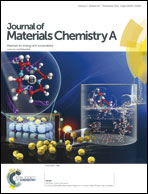An oxygen evolution catalyst on an antimony doped tin oxide nanowire structured support for proton exchange membrane liquid water electrolysis†
Abstract
Developing catalysts with high electrocatalytic activity has recently attracted much attention due to the slow reaction kinetics for oxygen evolution reaction (OER) and poor durability under harsh operating environments. Aiming at the enhancement of oxygen electrode kinetics and durability, a facile and scalable electrospinning method is employed to fabricate antimony doped tin oxide nanowires (Sb–SnO2 NWs) as support materials for iridium oxide. Both scanning electron microscopy (SEM) and transmission electron microscopy (TEM) results show that the as-prepared Sb–SnO2 NW is stacked from primary Sb–SnO2 nanoparticles (Sb–SnO2 NPs) with diameters of 15–25 nm and exhibits a uniform porous nanowire structure with diameters in the range of 200–300 nm. The synthesized Sb–SnO2 NW has a BET surface area of 60 m2 g−1 and an electronic conductivity of 0.83 S cm−1. Benefiting from the porous nanowire structure and high electronic conductivity of the Sb–SnO2 NW support, the supported IrO2 catalyst exhibits significant enhancement of mass activity toward OER in acidic electrolytes compared with that of Sb–SnO2 NP supported IrO2 catalyst and pure IrO2. The improved catalytic performance for OER is further confirmed by proton exchange membrane (PEM) electrolyzer tests at 80 °C. A test of such an electrolyzer cell at 450 mA cm−2 shows good durability within a period of up to 646 h.


 Please wait while we load your content...
Please wait while we load your content...